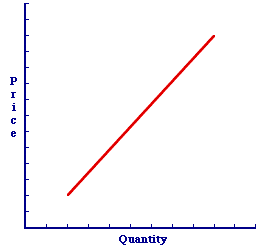
|
|
ABSOLUTE POVERTY: The amount of income a person or family needs to purchase an absolute amount of the basic necessities of life. These basic necessities are identified in terms of calories of food, BTUs of energy, square feet of living space, etc. The problem with the absolute poverty level is that there really are no absolutes when in comes to consuming goods. You can consume a given poverty level of calories eating relatively expensive steak, relatively inexpensive pasta, or garbage from a restaurant dumpster. The income needed to acquire each of these calorie "minimums" vary greatly. That's why some prefer relative poverty.
Visit the GLOSS*arama
|
|


|

|
                           OTHER PRICES, SUPPLY DETERMINANT: The prices of other goods that influence the decision to sell a particular good, which are assumed constant when a supply curve is constructed. Other prices can be for goods that are either substitutes-in-production or complements-in-production. This is one of five supply determinants that shift the supply curve when they change. The other four are resource prices, production technology, sellers' expectations, and number of sellers. The supply for one good is based on the prices of other goods that use the same resources for production. A change in the price of a substitute good (or substitute-in-production) induces sellers to alter the mix of goods produced, that is, to produce more of one good and less of another. An increase in the price of a substitute motivates sellers to sell less of this good as more of the substitute good is produced. A change in the price of a complement good (or complement-in-production) induces sellers to supply more or less of both goods, jointly. An increase in the price of a complement motivates sellers to sell more of this good as they sell more of the complement good, too.Substitute and ComplementWhen it comes to the other prices supply determinant, goods fall into one of two types--substitute and complement.- Substitute-in-Production: A substitute-in-production is one of two (or more) goods that is produced using the same resources in an either/or fashion. Supplies produce one good or the other, but not both. Devoting resources to the production of one good means they cannot be used to produce the other. An example is using farmland and other resources to produce one of two crops, either corn or soybeans.
- Complement-in-Production: A complement-in-production is one of two (or more) goods that is produced jointly with a given resource. One good is often produced as a bi-product of another. Producing one good does not prevent production of the other, but actually enables production of the other. Examples include beef and leather, both produced from the same cow.
Shifting the Supply Curve| Other Prices |  |
Changes in the prices of other goods cause the supply curve to shift. This can be illustrated using the positively-sloped supply curve for Wacky Willy Stuffed Amigos presented in this exhibit. This supply curve captures the specific one-to-one, law of supply relation between supply price and quantity supplied. Other prices are assumed to remain constant with the construction of this supply curve.Now, consider how changes in other prices shift the supply curve. The supply curve is affected in a different way for a change in the price of a substitute good than for a complement good. - Substitute-in-Production: An increase in the price of a substitute good causes a decrease in supply and a leftward shift of the supply curve. With the higher price, sellers sell more of the substitute good and less of this good. Click the [Other Price Up] button under the Substitute-in-Production heading to demonstrate.
A decrease in the price of a substitute good causes an increase in supply and a rightward shift of the supply curve. With the lower price, sellers sell less of the substitute good and more of this good. Click the [Other Price Down] button under the Substitute-in-Production heading to demonstrate.
- Complement-in-Production: An increase in the price of a complement good causes an increase in supply and a rightward shift of the supply curve. With the higher price, sellers sell more of the complement good and thus more of this good, too. Click the [Other Price Up] button under the Complement-in-Production heading to demonstrate.
A decrease in the price of a complement good causes a decrease in supply and a leftward shift of the supply curve. With the lower price, sellers sell less of the complement good and thus less of this good, too. Click the [Other Price Down] button under the Complement-in-Production heading to demonstrate.

Recommended Citation:OTHER PRICES, SUPPLY DETERMINANT, AmosWEB Encyclonomic WEB*pedia, http://www.AmosWEB.com, AmosWEB LLC, 2000-2025. [Accessed: July 18, 2025].
Check Out These Related Terms... | | | | | | | | | |
Or For A Little Background... | | | | | | | | | |
And For Further Study... | | | | | | | | | | | |
Search Again?
Back to the WEB*pedia
|



|

|
RED AGGRESSERINE
[What's This?]
Today, you are likely to spend a great deal of time at a flea market wanting to buy either a weathervane with a cow on top or a box of multi-colored, plastic paper clips. Be on the lookout for telephone calls from long-lost relatives.
Your Complete Scope
This isn't me! What am I?
|

|
|
A half gallon milk jug holds about $50 in pennies.
|

|
|
"A winner is someone who recognizes his God-given talents, works his tail off to develop them into skills, and uses those skills to accomplish his goals. " -- Larry Bird, basketball player
|

|
PDV
Present Discounted Value
|

|
|
Tell us what you think about AmosWEB. Like what you see? Have suggestions for improvements? Let us know. Click the User Feedback link.
User Feedback
|


|


